Estuarine
Turbidity Maximum (ETM)
|
(Dynamic
stability and particle transformations: tracing pathways of production
in
Estuarine Turbidity Maxima (NSF-OCE-0453905), P.I.s: E. D. Houde, B. C.
Crump, E. W. North, M. R. Roman, L. P. Sanford, Senior Investigators:
S.-Y. Chao, R. R. Hood, D. Kimmel) |
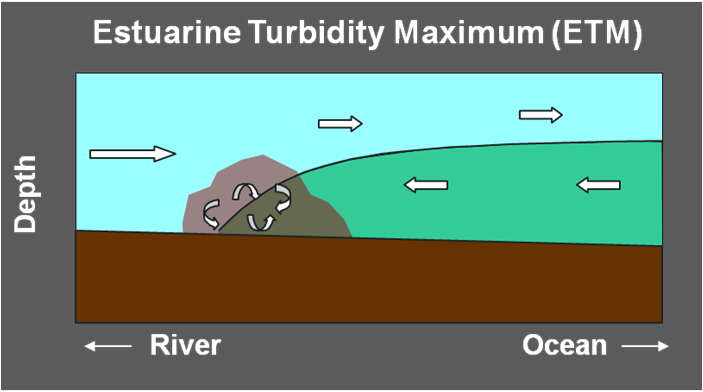
| Fig.
1 Conceptual diagram of estuarine turbidity maximum regions (gray
area). Arrows indicate the direction of water flow; freshwater above
and seawater below the pycnocline which is shown with a line. |
|
|
| The
ETM can be found worldwide anywhere seawater meets
freshwater (Fig. 1). Less dense freshwater flows over the top of
seawater and it
creates a sharp gradient of salinity called a pycnocline. At a front head
of seawater
we typically measure the highest concentration of suspended
sediment particles because of friction between the pycnocline and
sediments. Due to the dynamic stability of ETM circulation patterns, most
suspended particles are trapped in this region, and that is why we call
the region the estuarine turbidity maximum. |
|
The ETM supports the highest secondary
production, including zooplankton, larval and juvenile fish, in
estuarine environments because it traps organic matter and
hydrodynamically concentrates
prey items for secondary producers. For these reasons, striped bass
(aka. rock fish) migrate
from the Altantic Ocean to the Chesapeake Bay ETM region every year in
April and May
to breed and spawn eggs. There are at least three reasons
why they spawn eggs in the ETM:
(1) Optimal density for their large
bouyant eggs
(2) Reduced predation stress
(3) Abundant food items |
|
| Our main objective of this study is to identify
pathways
of energy flow from the delivery of organic matter to the production of
larval and juvenile fish. Our overarching hypothesis (Fig. 2) is
dynamiy ETM circulation increases the quantity and quality of prey items (e.g.,
microaggregates, zooplankton) for secondary production. |
|
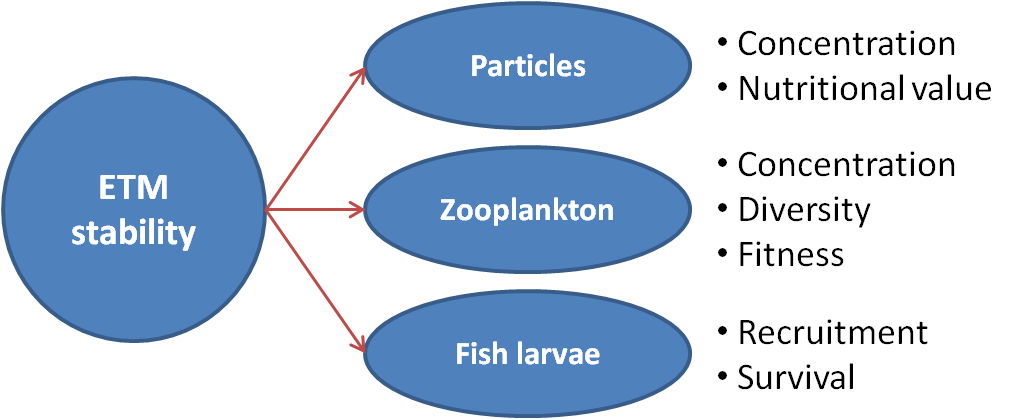
| Fig.
2 Overarching hypotheses covering the delivery of organic matter
and microbial organisms up to the highest trophic level organisms. |
|
|
| In the ETM project, I was in charge of
measuring community metabolism, including primary production and
community respiration, and developing ecosystem food web models.
Primary production and respiration are the most basic form of biological
processes conducted by all living things and we can estimate how much energy
is produced and consumed. For example, net ecosystem metabolism,
calculated by
subtracting community respiration from gross primary production, is
often used to estimate whether the system is dependent on organic
matter produced in the same ecosystem (autochthonous) or imported from
external sources (allochthonous). |
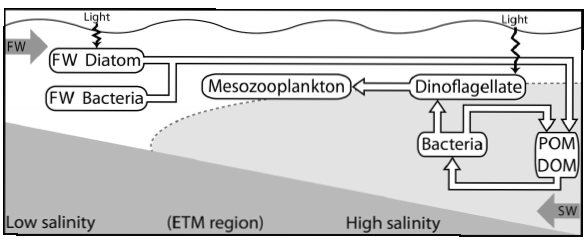
| Fig.
3 Energy
flow diagram illustrating the estuarine food web in the Chesapeake Bay
estuarine turbidity maximum (ETM) region. FW: fresh water; SW: sea
water; POM: particulate organic matter; DOM: dissolved organic matter;
dotted line: pycnocline. Details are discussed in Lee et al.
(2012). |
|
|
| My research indicates that heterotrophic
organisms in
the ETM are strongly dependent on both autochthonous and allochthonous
organic
matter but with strong seasonal variation (Fig. 3). It is because the
strength of the ETM is highly associated with river discharge which
usually peaks in early spring. Therefore, the contrubition of
particle-attached and free-living bacteria was relatively higher than
that of phytoplankton production in April when the ETM was the strongest.
Most interestingly, however, dinoflagellates appear to be the greatest
contributor for both
primary production and community respiration because abudant
dinoflagellates (e.g., Heterocapsa
rotundatum, Prorocentrum
minimum) are mixotrophs that can live (or switch) to both
autotrophic and
heterotrophic life styles. |
|
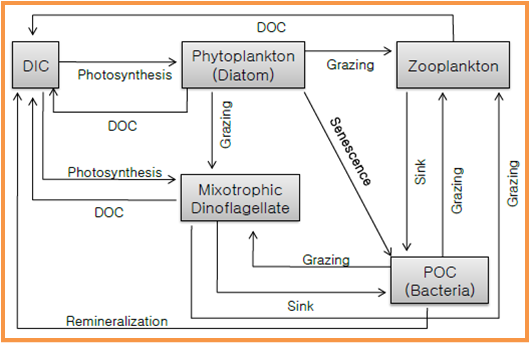
| Fig.
4 Nutrient-Phytoplankton-Zooplankton-Bacteria model was prepared
(Stellar software) to test a hypothesis suggesting that the contribution of
dinoflagellates as both primary and secondary producers is a key
mechanism resulting in efficient energy transfer to higher
trophic
level organisms. |
|
|
| I developed
a NPZD (i.e., nutrients, phytoplankton,
zooplankton, detritus) model using STELLA software to simulate how the
physiological advantage of dinoflagellates causes highest secondary
production in the ETM region (Fig. 4). Model results suggest that
dinoflagellates transfer bacterial and detrital organic matter
efficiently to omnivorous estuarine copepods that are heavily grazed by
fish larvae. |
|
| I have mainly talked about biological
mechanisms resulting in high secondary production. However, it is
difficult to explain such high secondary production without considering
physical mechanisms concentrating all kinds of small particles in the
ETM. So, I developed another model, called the Box model, to create a
simulation of ETM physics (Fig. 5). I parameterized the model
with actual values of various envioronmental measurements such as
phytoplankton concentrations, river flow, water advection, diffusion,
mixing, and most importantly sinking rates which were acquired from the
Owen Tube experiment. The model results suggest that the
function
of ETM physics is also critical to increase the concentration of labile
organic matter in the ETM regions. |
|
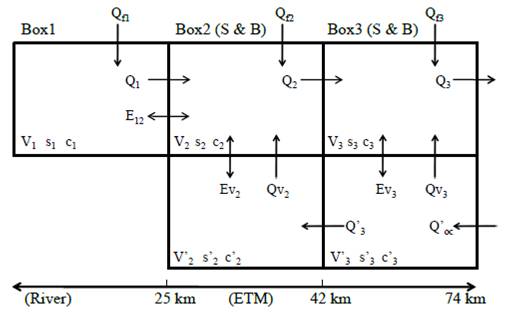
| Fig.
5 Schematic diagram of the Box model structure. The oligohaline region
of Chesapeake Bay has longitudinally separated into three regions
representing the upstream, ETM, and downstream. |
|
|

